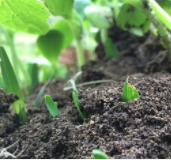
Cinderite Water Retention Study
UP TO 65% WATER RETENTION! - Volcanic Mulch Saves Water!
Water scarcity and soil salinity are the most important limiting factors for agricultural expansion in arid and semi-arid regions. High evaporation in these regions, cause excessive soil water loss, and soil salinization, and mulching is an effective way to reduce evaporation losses. Different types of mulch includes organic mulch (such as crop residues and pruned branches), synthetic mulches (such as asphalts and plastic sheets), and inorganic materials. Wheat straw as mulch in conjunction with deep tillage improve the soil’s physical health and maize crop quality.
Drip irrigation in combination with plastic mulch was found to be a more effective irrigation method, improving WUE and increasing cantaloupe yield. Inorganic mulches such as gravel and sand, even as thick as 5-10 mm, can increase water infiltration and soil moisture storage. The use of sand and gravel mulches to improve soil moisture status is well documented. Recent investigations demonstrated the effectiveness of volcanic soil amendments in reclamation of saline soil and water evaporation reduction.
These materials are relatively lightweight compared to other minerals and have long durability and high hydraulic conductivity, and are not a medium for pest and disease growth. If porosity is present, they can absorb and hold significant amounts of water and increase rain water infiltration into the soil.
In a laboratory column study with volcanic rock mulches (VM) Cinderite. 2, 5 and 10 cm thickness of a medium-grain VM, reduced cumulative evaporation by 52%, 83% and 92%. The difference in reduction of accumulated evaporation between 5 cm thickness of fine, medium, and coarse grain sizes were not significantly different, and ranged between 79% to 81%.
Volcanic mulches (Cinderite) (VM) play a vital role in agricultural economy. Their uses have made it possible for rain-fed and irrigated production of crops such as corn, potato, onion, melons, hemp, cannabis, grapes and Lettuce, spinach and kale in fairly arid areas, where the mean annual rainfall and evaporation are rapidly increasing year after year respectively. More than 30% of North America is comprised of arid or semi-arid lands, with about 40% of the continental US at risk for desertification. The successful experiences from around the US can be implemented in rain-fed and irrigated orchards in the US, to reduce evaporative water loss and increase water retention by 50-70%.
KEY FINDINGS
The objective of this study was to evaluate the efficiency of volcanic rock mulch (VM) on reducing the water evaporation from the soil. The thickness of the VM is important in its efficiency and cost. Consequently, a completely randomized design experiment with soil columns was conducted outdoor for 32 days, with four treatments and four replications.
The treatments consisted of a control (no mulch), and three VM thicknesses (5, 10 and 15 cm). The grain size of VM was between 1-1.5 cm. After the addition of 320 ml of water to each column, mulch treatments were applied, and the columns were weighed. They were weighed daily for the next 7 days and then every three days. There was a significant reduction in cumulative evaporation from the soil compared to control. The 5, 10 and 15 cm thickness of VM reduced water evaporation by an astounding 25%, 65% and 66%.
There was no significant difference between 10 and 15 cm thicknesses of Cinderite VM. It is concluded that 10 cm of Cinderite can effectively reduce soil moisture loss. This has practical application in rain-fed and irrigated orchards in arid and semi-arid regions across the USA.










